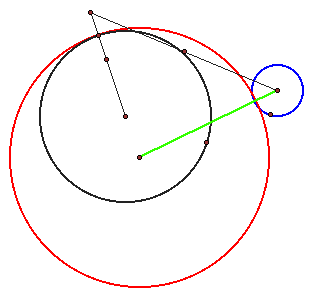

Two circles are tangent when they share one point (the point of tangency).
Let's construct a circle tangent to two circles.

One circle was drawn with another circle inside. (The second circle can be drawn inside or outside the first circle). Next, an arbitrary point was selected on the outside circle. A line was constructed through the arbitrary point and the radius of the outside circle. The radius of the inside circle was found, and another circle was constructed at the arbitrary point on the outside circle using the radius of the inside circle. A segment was constructed from the radius of circle C to the radius of circle B. The midpoint of the segment was found and a perpendicular line through the midpoint was constructed. A circle was constructed around the intersection of the line through the outside circle.

Let's look at the segment between the center of circle C and the center of circle B.

The length of this segment is the sum of the radius of circle C and the radius of circle B.

Since this circle's radius is the legnth of our segment connecting B and C's centers, these segments form an isosceles triangle. The center of the tangent circle C lies on the perpendicular bisector of the base of this triangle.
Let's trace the locus of circle C.
The locus of the center of our tangent circle forms an ellipse.
What if our second circle is outside the larger circle? What will the tangent circle look like?

What happens when we trace the locus of the center of the tangent circle?
The trace forms a hyperbola and looks like the following picture.

What if our two original circles intersect? What will the tangent circle look like?

The tangent (red) circle is inside the larger circle. Let's move the intersection of the small circle and tangent circle around the tangent circle and see how the tangent circle changes.
We can see that the tangent circle remains inside the two circles. It moves from inside the larger circle to inside the small circle and back again.
As we look at the trace of the locus of the center of the tangent circle, we can see that it forms an ellipse.